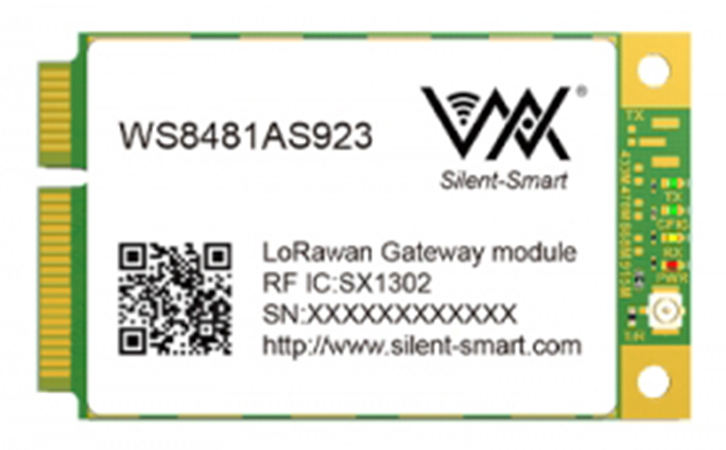A LoRa module is a hardware component that incorporates the LoRa wireless communication technology. It is designed to enable long-range, low-power communication for Internet of Things (IoT) devices. LoRa modules typically consist of a transceiver chip that implements the LoRa modulation scheme, along with additional components such as a microcontroller, antenna, and interfaces for connecting to other devices.
The LoRa modulation technique allows for long-range communication with low power consumption, making it ideal for applications that require wide area coverage and battery-operated devices. The modules provide a convenient way to integrate LoRa functionality into IoT devices, such as sensors, actuators, and other connected devices.
LoRa modules usually operate in the license-free ISM (Industrial, Scientific, and Medical) bands, such as 868 MHz in Europe and 915 MHz in North America. They support point-to-point communication as well as the creation of LoRaWAN (Long Range Wide Area Network) networks, which enable devices to communicate with gateways and connect to the internet.
These modules often come with software libraries and development tools to simplify the integration and programming process. They can be used in a wide range of applications, including smart cities, agriculture, asset tracking, environmental monitoring, and industrial automation, among others.
How far can LoRa transmit?
The maximum transmission range of LoRa (Long Range) technology can vary depending on several factors, including the specific LoRa module, the environment, and the regulatory limitations of the region. However, LoRa is designed to provide long-range communication capabilities compared to traditional wireless technologies.
In ideal conditions, with a clear line of sight and minimal interference, LoRa can achieve ranges of several kilometers (up to 10 kilometers or more). This extended range is made possible by the use of low data rates, robust modulation, and efficient power management techniques.
The actual range achievable in practice can be influenced by various factors, including terrain, buildings, vegetation, and other obstacles that may attenuate or block the radio signals. In urban environments with many obstacles, the range may be reduced compared to open rural areas.
It’s worth noting that LoRa is a low-power technology optimized for long-range communication rather than high data rates. The trade-off for long-range communication is lower data throughput. The achievable data rates typically range from a few hundred bits per second to several kilobits per second, depending on the LoRa module and configuration.
To determine the specific range for a particular deployment, it is recommended to conduct range testing in the target environment or refer to the specifications and documentation provided by the LoRa module manufacturer.
What is the advantage of using LoRa?
There are several advantages to using LoRa (Long Range) technology for wireless communication in IoT applications:
- Long Range: LoRa offers exceptional long-range capabilities, allowing devices to communicate over several kilometers, even in challenging environments. This extended range enables wide area coverage with fewer infrastructure requirements, making it suitable for applications like smart cities, agriculture, and industrial monitoring.
- Low Power Consumption: LoRa is designed for low-power operation, enabling devices to operate on batteries for extended periods. The technology utilizes efficient modulation schemes and power management techniques, making it ideal for IoT devices that require long battery life, such as sensors and remote monitoring devices.
- Scalability: LoRa supports scalable network architectures, allowing for the deployment of large-scale IoT applications. It can accommodate a massive number of devices, making it suitable for applications with thousands or even millions of connected devices. The LoRaWAN protocol, built on top of LoRa, provides a standardized framework for managing and scaling IoT deployments.
- Cost-Effective: LoRa technology offers a cost-effective solution for IoT connectivity. It operates in unlicensed frequency bands, eliminating the need for expensive spectrum licenses. Additionally, the long-range capabilities reduce the infrastructure requirements, resulting in lower deployment costs compared to cellular or other wireless technologies.
- Robustness: LoRa utilizes a robust modulation scheme that provides resilience to interference and noise. It can penetrate obstacles such as buildings and vegetation, maintaining reliable communication in challenging environments. This robustness makes LoRa suitable for applications in urban areas and industrial settings.
- Flexibility: LoRa supports both point-to-point communication and the creation of LoRaWAN networks. LoRaWAN enables devices to connect to gateways and communicate with cloud platforms, providing connectivity and data exchange on a larger scale. The flexibility of LoRa allows for various deployment scenarios and integration with existing infrastructure.
Overall, the combination of long-range capabilities, low power consumption, scalability, cost-effectiveness, robustness, and flexibility makes LoRa an attractive choice for a wide range of IoT applications, particularly those that require extended coverage, low-power operation, and cost-efficient connectivity.
